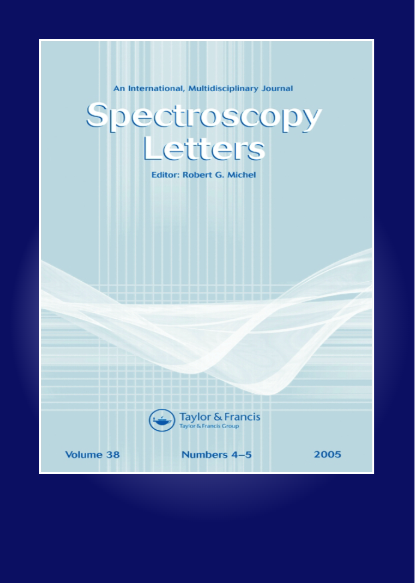便携式拉曼光谱仪用于食用油中棕榈油掺假的直接鉴别
IF 1.6
4区 化学
Q3 SPECTROSCOPY
引用次数: 0
摘要
摘要油中常见的掺假工艺是将低成本和高成本食用油混合。棕榈油在印度市场上被广泛用作掺假剂。在本工作中,将不同比例的棕榈油与葵花籽油、花生油、椰子油、姜油等高价食用油混合。使用便携式拉曼光谱仪研究了所有食用油单独和混合棕榈油后的拉曼峰强度。838 cm−1、868 cm−1、973 cm−1、1077 cm−1、1262 cm−1、1300cm−1、1438 cm−1、1655 cm-1和1745 cm−1处的峰值代表了(C - C)拉伸引起的振动,(CH)顺式(- CH=CH -)、δ(=CH)、骨架C - C拉伸、(CH)变形、CH2基团的剪切振动,(C=C)顺式- (CH=CH -)拉伸,(C=O)顺式- (CH=CH -)拉伸和(C=O)顺式(RC=OOR)拉伸引起的振动。曾尝试在100毫升高成本食用油中检测出12.5毫升棕榈油。加入超过12.5 mL的掺假油后,拉曼峰消失。食用油的峰消失值分别为:葵花籽油973 cm−1,花生油970 cm−1,椰子油1122 cm−1,肉桂油1745 cm−1。获得的结果将用于未来的数据分析,以直接检测油中的掺假物。关键词:掺假棕榈油食用油掺假率拉曼光谱《神巴木思》:概念化、数据整理、调研、写作——原稿。S. Karthiga Devi:实验分析,软件。K. Prem Ananth:《可视化》的写作、评论和编辑。Naidu Dhanpal Jayram:资源,验证,项目管理,资金获取,监督。通讯作者谨代表所有作者声明,本研究不存在利益冲突。资助作者之一Naidu Dhanpal Jayram感谢dst -塞族文件号SRG 001576/2019为启动研究提供资助。本文章由计算机程序翻译,如有差异,请以英文原文为准。
Direct discrimination of palm oil as an adulterant in edible oils using a portable Raman spectrometer
AbstractThe common adulteration process in oils involves mixing low-cost and high-cost edible oils. Palm oil has been widely used as an adulterant in the Indian market. In the present work, different ratios of palm oil were mixed with high-cost edible oils such as sunflower, groundnut, coconut, and gingelly. Raman peak intensity for all edible oils individually and after mixing palm oil as an adulterant was studied using a portable Raman spectrometer. The peaks at 838 cm−1, 868 cm−1, 973 cm−1, 1077 cm−1, 1262 cm−1,1300cm−1, 1438 cm−1, 1655 cm-1, and 1745 cm−1 represent vibration due to the (C–C) stretching, (CH) wagging from cis (–CH = CH–), δ(=CH), skeletal C–C stretching, (CH) deformation of (CH2), scissoring vibration of CH2 group, (C=C) stretching from cis –(CH=CH–), and (C=O) stretching vibration from (RC=OOR) for sunflower oil, groundnut oil, gingelly oil, and coconut oil. An attempt has been made to detect 12.5 mL of palm oil in 100 mL of high-cost edible oil. Raman peaks disappeared while adding more than 12.5 mL of adulterate oil. The disappearance of peaks in edible oils, 973 cm−1 for sunflower oil, 970 cm−1 for groundnut oil, 1122 cm−1 for coconut oil, and 1745 cm−1 for gingelly oil respectively. The obtained results will be used for futuristic data analysis to directly detect adulterants in the oils.Keywords: Adulterated with palm oiledible oilspercentage of adulterationRaman spectroscopy Authors’ contributionS. Shenbagamoorthi: Conceptualization, Data curation, Investigation, Writing—original draft. S. Karthiga Devi: Experimental Analysis, Software. K. Prem Ananth: Writing—review and editing, Visualization. Naidu Dhanpal Jayram: Resources, Validation, Project administration, Funding acquisition, Supervision.Disclosure statementOn behalf of all authors, the corresponding author states that there is no conflict of interest.Additional informationFundingOne of the authors, Naidu Dhanpal Jayram acknowledges DST-SERB File no SRG 001576/2019 for providing a startup research grant.
求助全文
通过发布文献求助,成功后即可免费获取论文全文。
去求助
来源期刊

Spectroscopy Letters
物理-光谱学
CiteScore
2.90
自引率
5.90%
发文量
50
审稿时长
1.3 months
期刊介绍:
Spectroscopy Letters provides vital coverage of all types of spectroscopy across all the disciplines where they are used—including novel work in fundamental spectroscopy, applications, diagnostics and instrumentation. The audience is intended to be all practicing spectroscopists across all scientific (and some engineering) disciplines, including: physics, chemistry, biology, instrumentation science, and pharmaceutical science.
 求助内容:
求助内容: 应助结果提醒方式:
应助结果提醒方式:


